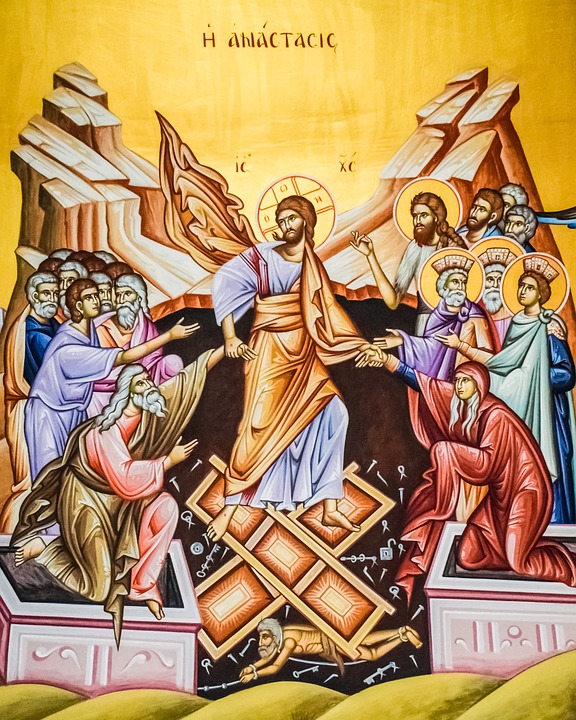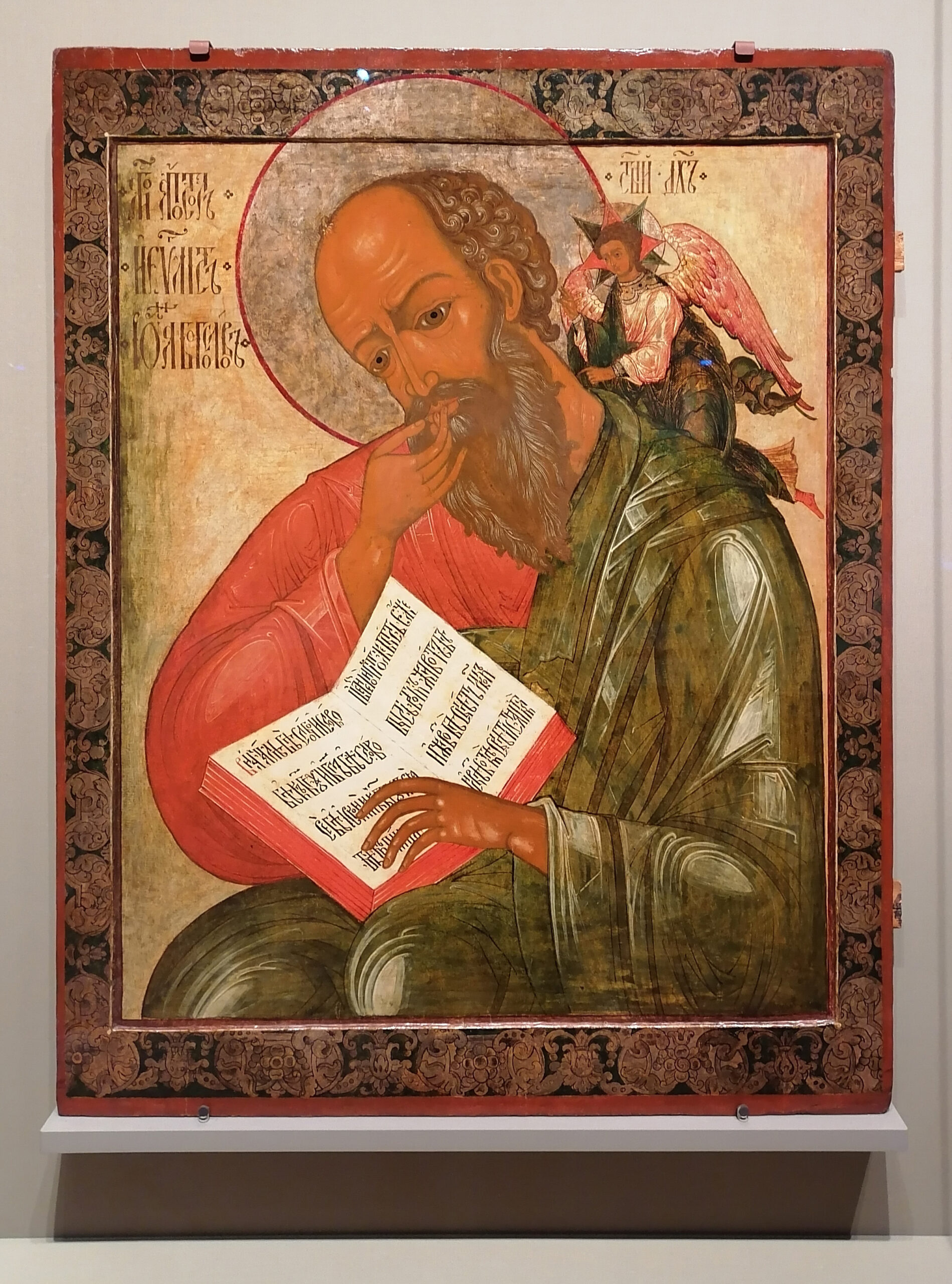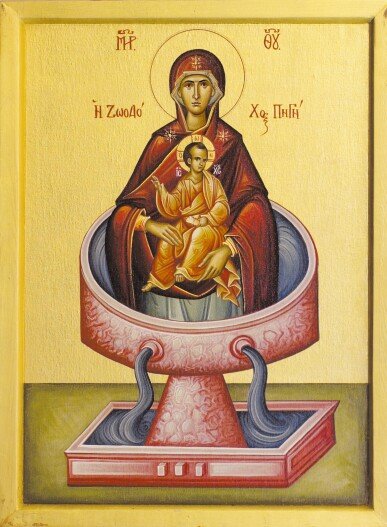Now after the Sabbath, toward the dawn of the first day of the week, Mary Magdalene and the other Mary went to see the sepulcher. And behold, there was a great earthquake; for an angel of the Lord descended from heaven and came and rolled back the stone, and sat upon it. His appearance was like lightning, and his raiment white as snow. And for fear of him the guards trembled and became like dead men. But the angel said to the women, “Do not be afraid; for I know that you seek Jesus who was crucified. He is not here; for He has risen, as He said. Come, see the place where He lay. Then go quickly and tell His disciples that He has risen from the dead, and behold, He is going before you to Galilee; there you will see Him. Lo, I have told you.” So they departed quickly from the tomb with fear and great joy, and ran to tell his disciples. And behold, Jesus met them and said, “Hail!” And they came up and took hold of His feet and worshiped Him. Then Jesus said to them, “Do not be afraid; go and tell My brethren to go to Galilee, and there they will see Me.” While they were going, behold, some of the guard went into the city and told the chief priests all that had taken place. And when they had assembled with the elders and taken counsel, they gave a sum of money to the soldiers and said, “Tell people, ‘His disciples came by night and stole Him away while we were asleep.’ And if this comes to the governor’s ears, we will satisfy him and keep you out of trouble.” So they took the money and did as they were directed; and this story has been spread among the Jews to this day.
Matthew 28:1-15
Christ is Risen!
For the month of May, we’re going to discuss the post-Resurrection passages of the Gospels, returning to “The Heart of Encouragement” on June 1.
In the Orthodox Church, there are eleven Gospel passages, called “Eothina” which cover the Resurrection accounts and the post-Resurrection appearances of Christ. There is one from Matthew, two from Mark, three from Luke, and five from John.
Each Gospel account of the Resurrection is “similar”, though there are small, subtle differences. And not every “eothina” talks about the Resurrection. Actually, only three of them do. Matthew’s account is not covered. And the other eight concern post-Resurrection appearances.
There is, however, one Resurrection passage that is not part of the Eothina, which is Matthew 28:1-15, which we will discuss today.
Of the four Gospel accounts of the Resurrection, this is the only one that discusses the moment of the Resurrection. The others talk about how the tomb was found empty. Matthew’s Gospel describes an earthquake, and an angel of the Lord descending from heaven and rolling back the stone. Mary Magdalene and the other Mary are the first to encounter the angel. The number of women varies between the Gospel accounts. What does not vary is that it was the women, not the disciples, who first encountered the empty tomb and who were the first to spread the news of the Resurrection.
The description of the Resurrection itself is very powerful: an earthquake, an angel coming from heaven and rolling back the stone. The appearance of the angel is as bright as lightning. The guards, trembling and probably fainting from fear, are unable to behold the bright countenance of the angels. This is presumably why they do not see Jesus walk out of the tomb.
Shortly thereafter, Jesus Himself appears to the women, telling them that He is going to Galilee and the disciples would see Him there. This is the first of what will be several post-Resurrection appearances of Jesus.
From the moment of the Resurrection, up until this day, there has been a movement throughout the world, throughout each age and each country, to discredit the Resurrection. Many times, this movement has been led by a government. In this first Resurrection Gospel, the chief priests collude with government officials to concoct a lie about the Resurrection. The soldiers are given money in exchange for telling a lie about what happened.
And here is where the chief battle lies in Christianity, the battle of faith. There are people in every generation who discredit the Resurrection, thereby discrediting Christianity. And there are people in every generation who live their lives with Christ at the center of them. He is the purpose, focus, and hope of the life of each Christian.
At some point, each person is confronted with Christianity, and each makes a choice, to follow or not, to believe or not. Pascha didn’t end the Christian journey. It ended a chapter, this year’s Lenten journey is over. The story, however, for you, and for me, isn’t over. How will today’s chapter play out in your Christian journey? Will you live the faith today? Will it matter for you today? Or will you set it aside today?
The Resurrection is either the greatest event in the history of humanity or the biggest lie ever perpetuated. I believe it is the former, and I try to pattern my life to reflect that reality. There is no question I have a lot farther to go in my journey to Christ. But the first step is belief in the Resurrection, and I took that step many, many, many years ago. If you haven’t taken that step, keep coming, keep studying, bring your questions, so that you can believe in this very central tenet of the Christian faith. And if you are a person of faith, it’s time to think about how you can be more faithful in your practice of our faith.
When the women with Mary had come before dawn, and they found that the stone had been rolled away from the sepulcher, they heard from the Angel, “Why do you seek among the dead, as a mortal man, the One who exists in everlasting light? See the grave clothes in the sepulcher. Run and proclaim to the world that the Lord has risen and put death to death; for He is the Son of God who saves the human race. (Hypakoe, from the Matins of the Resurrection, Trans. by Fr. Seraphim Dedes)
Don’t forget to pray today!



